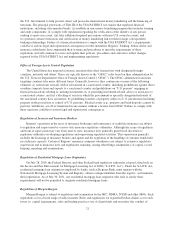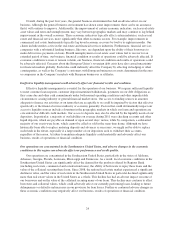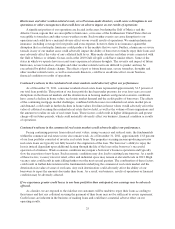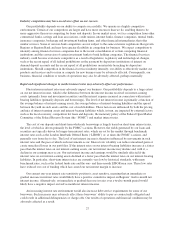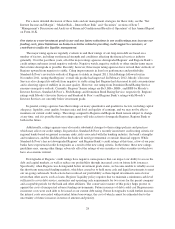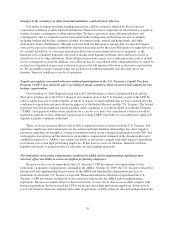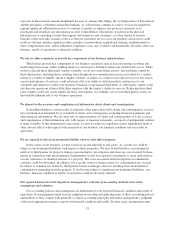Regions Bank 2011 Annual Report Download - page 47
Download and view the complete annual report
Please find page 47 of the 2011 Regions Bank annual report below. You can navigate through the pages in the report by either clicking on the pages listed below, or by using the keyword search tool below to find specific information within the annual report.Employees
As of December 31, 2011, Regions and its subsidiaries had 26,813 employees.
Available Information
Regions maintains a website at www.regions.com. Regions makes available on its website free of charge its
annual reports on Form 10-K, quarterly reports on Form 10-Q and current reports on Form 8-K, and amendments
to those reports which are filed with or furnished to the SEC pursuant to Section 13(a) of the Securities Exchange
Act of 1934. These documents are made available on Regions’ website as soon as reasonably practicable after
they are electronically filed with or furnished to the SEC. Also available on the website are Regions’
(i) Corporate Governance Principles, (ii) Code of Business Conduct and Ethics, (iii) Code of Ethics for Senior
Financial Officers, (iv) Expenditures Policy, and (v) the charters of its Nominating and Corporate Governance
Committee, Audit Committee, Compensation Committee and Risk Committee.
Item 1A. Risk Factors
Risks Related to the Operation of Our Business
Our businesses have been and may continue to be adversely affected by conditions in the financial markets
and economic conditions generally.
The capital and credit markets since 2008 have experienced unprecedented levels of volatility and
disruption. In some cases, the markets produced downward pressure on stock prices and credit availability for
certain issuers without regard to those issuers’ underlying financial strength.
Dramatic declines in the housing market during recent years, with falling home prices and increasing
foreclosures, unemployment and under-employment, have adversely affected the credit performance of real
estate-related loans and resulted in, and may continue to result in, significant write-downs of asset values by us
and other financial institutions, including government-sponsored entities and major commercial and investment
banks. These write-downs, initially of mortgage-backed securities but spreading to credit default swaps and other
securities and loans, have caused many financial institutions to seek additional capital, to reduce or eliminate
dividends, to merge with larger and stronger institutions and, in some cases, to fail. Reflecting concern about the
stability of the financial markets generally and the strength of counterparties, many lenders and institutional
investors have reduced, and in some cases, ceased to provide funding to borrowers, including financial
institutions.
Although the economic slowdown that the United States experienced has begun to reverse and the markets
have generally improved, business activities across a wide range of industries continue to face serious difficulties
due to the lack of consumer spending and the lack of liquidity in the global credit markets. A sustained weakness
or weakening in business and economic conditions generally or specifically in the principal markets in which we
do business could have one or more of the following adverse effects on our business:
• A decrease in the demand for loans and other products and services offered by us;
• A decrease in the value of our loans held for sale or other assets secured by consumer or commercial
real estate;
• An impairment of certain intangible assets, such as goodwill;
• A decrease in interest income from variable rate loans, due to fluctuations in interest rates; and
• An increase in the number of clients and counterparties who become delinquent, file for protection
under bankruptcy laws or default on their loans or other obligations to us. An increase in the number of
delinquencies, bankruptcies or defaults could result in a higher level of nonperforming assets, net
charge-offs, provisions for loan losses, and valuation adjustments on loans held for sale.
23










